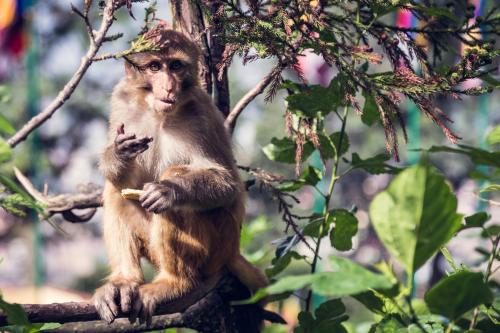
Virus Plasticity in Biodiverse Landscapes

About
Rapid changes to natural landscapes and the biodiversity of plants and animals are altering relationships between viruses and their natural hosts with direct implications for human health. Landscape changes, including deforestation and habitat fragmentation, create new ecosystem edges where biodiversity tends to be different than in the interior. This can contribute to altered vertebrate and vector host species community composition, movements, habitat choices, creating new inter-species and animal-human interactions and increasing opportunities for zoonotic spillover. Given the broad scale at which these changes are occurring around the world, investigation is needed on the impacts of biodiversity and landscape change on virus characteristics that determine zoonotic potential, including the diversity of host species a virus can infect in nature, or virus “host plasticity”. Higher host plasticity is often linked to an increased likelihood of human-to-human viral transmission and wider geographic spread, factors which can predict outbreak potential and severity. This project seeks to understand whether landscape and biodiversity change drive viruses towards greater host plasticity and therefore heightened pandemic risk. Findings will contribute to ecological theory on the impact of environmental changes on microbial adaptation and practical implications for management of high-risk ecosystems for pathogen spillover. Training opportunities provided through this project will help foster a network of cross-trained scientists interested in disease dynamics, public health, and animal health who will strengthen future One Health research.
Our Research
Creation of new ecosystem boundaries through habitat fragmentation increases opportunities for viruses to adapt to new hosts at those boundary edges, which could influence virus host plasticity and increase spillover risk. To test this hypothesis, our research will investigate the host range of bat-borne coronaviruses and mosquito-borne arboviruses (flaviviruses, alphaviruses and bunyaviruses) across replicated gradients of landscape change and community composition, with field sampling efforts focused on bats, primates, and mosquitoes in biodiverse tropical forests. Theoretical and computational modeling, underpinned by field investigations and in vitro experiments, will evaluate (1) how virus host and vector plasticity changes at the edge of ecosystems, such as at the boundary between forest and urban habitats, 2) how virus host plasticity relates to virus epidemiology across landscapes, and 3) how intra-host viral genetic diversity is influenced by host and vector plasticity. Data and model driven insights will inform on the role mosquito vectors play in constraining or expanding virus host plasticity and genetic diversity. Characterization of bat-borne coronaviruses and host affinities in an ecosystem with SARS-CoV-related viruses will further inform on coronavirus evolution and emergence of zoonotic potential. Exploring this paradigm of functional relationships between biodiversity and public health will advance a mechanistic understanding of zoonotic virus emergence, with the potential for generalization to other systems. Our findings will be especially relevant for guiding policy and mitigation efforts focused on the relationship between environmental change, biodiversity, disease outbreaks, and pandemics.
Publications
- Evensen C, White A, Boots M. Multispecies interactions and the community context of the evolution of virulence. Proc R Soc B. 2024 Sep;291(2031):20240991. https://doi.org/10.1098/rspb.2024.0991
- Aung PP, Lwin N, Aung TH, Htike TSM, Thompson C, Roos C, Zaw SM, Lum LZ, Oo WN, Sau Z, Turvey ST, Thein WZ, Maw MT, Win YT, Oo ZM, Van Rompay KKA, Gilardi KV, Tremeu-Bravard A, Momberg F, Fan PF, Cheyne SM, Smiley Evans T. Confirmation of Skywalker Hoolock Gibbon (Hoolock tianxing) in Myanmar Extends Known Geographic Range of an Endangered Primate. International Journal of Primatology. 2024 Feb 14. https://doi.org/10.1007/s10764-024-00418-6
- Thompson C, Lwin N, Aung PP, Aung TH, Htike TSM, San AM, et al. The status of primates and primatology in Myanmar. Global Ecology and Conservation 2023;47:e02662. https://doi.org/10.1016/j.gecco.2023.e02662
- Brook CE, Rozins C, Guth S, Boots M. Reservoir host immunology and life history shape virulence evolution in zoonotic viruses. PLoS Biol 2023;21:e3002268. https://doi.org/10.1371/journal.pbio.3002268
- Johnson CK, Freeman JME, Smiley Evans T, Montecino-Latorre D, Uhart MM. Chapter 25. Emerging Coronaviruses: A One Health Harbinger. In: Jessup DA, Radcliffe RW, editors. Wildlife Disease and Health in Conservation, Johns Hopkins University Press; 2023. https://doi.org/10.56021/9781421446745
- Evans TS, Tan CW, Aung O, Phyu S, Lin H, Coffey LL, et al. Exposure to diverse sarbecoviruses indicates frequent zoonotic spillover in human communities interacting with wildlife. International Journal of Infectious Diseases 2023;131:57–64. https://doi.org/10.1016/j.ijid.2023.02.015
This work is supported by the National Science Foundation (NSF), award number 2109860, titled "Impacts of Rapid Landscape Change and Biodiversity on Virus Host Specificity."
